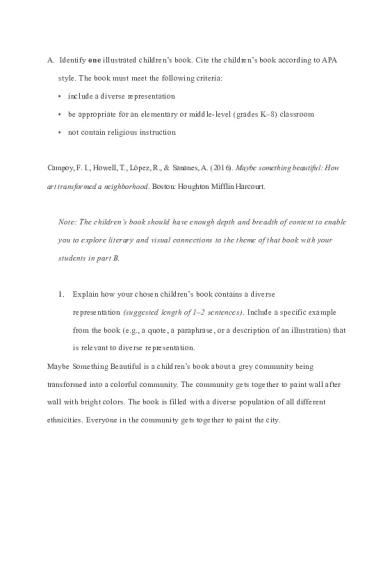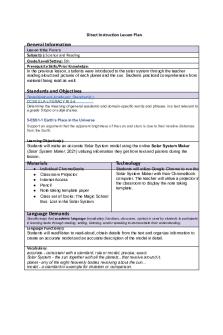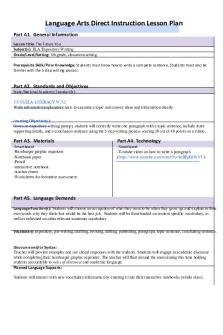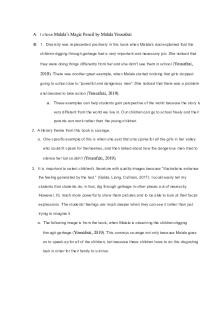Task 1 - Lesson Plan PDF

| Title | Task 1 - Lesson Plan |
|---|---|
| Course | Children's Literature |
| Institution | Western Governors University |
| Pages | 8 |
| File Size | 185 KB |
| File Type | |
| Total Downloads | 88 |
| Total Views | 189 |
Summary
Lesson Plan...
Description
A. Identify one illustrated children’s book. Cite the children’s book according to APA style. The book must meet the following criteria: • include a diverse representation • be appropriate for an elementary or middle-level (grades K–8) classroom • not contain religious instruction
Campoy, F. I., Howell, T., López, R., & Sananes, A. (2016). Maybe something beautiful: How art transformed a neighborhood. Boston: Houghton Mifflin Harcourt.
Note: The children’s book should have enough depth and breadth of content to enable you to explore literary and visual connections to the theme of that book with your students in part B.
1.
Explain how your chosen children’s book contains a diverse representation (suggested length of 1–2 sentences) . Include a specific example from the book (e.g., a quote, a paraphrase, or a description of an illustration) that is relevant to diverse representation.
Maybe Something Beautiful is a children’s book about a grey community being transformed into a colorful community. The community gets together to paint wall after wall with bright colors. The book is filled with a diverse population of all different ethnicities. Everyone in the community gets together to paint the city.
2.
Describe one literary theme found in the book that helps the reader gain a perspective for understanding the world. Include an example from the book (e.g., a quote, a paraphrase, or a description of an illustration).
The theme of this book is diversity in a community. A community of diverse people can come together and create something beautiful together, no matter their background, ethnicity, race, culture. 3. Identify the specific genre of the book and describe two characteristics of that genre present in the book. The genre of this book is a children’s fiction book. Children’s books are often filled with illustrations and are written using simpler language structures. Fiction books are derived from someone’s imagination and often contain unrealistic characteristics such as talking animals or magical powers. Maybe Something Beautiful is filled with illustrations and is created from someone’s imagination of a grey town being filled with color.
GENERAL INFORMATION
Lesson Title & Subject(s): Maybe Something Beautiful
Topic or Unit of Study: Reading
Grade/Level: 1st Grade
Instructional Setting:
• 26 students total (15 boys and 11 girls) • 19 students are on-grade-level readers • 5 students are two grades above reading level (2 with identified gifted exceptionalities) • 2 students are English language learners at the intermediate level For this specific lesson, all desks are arranged in one large group towards the back of the classroom with a circle reading carpet in the front of the room in front of the SMART Board and teacher desk.
STANDARDS AND OBJECTIVES
Your State Core Curriculum/Student Achievement Standard(s): Retell stories, including key details, and demonstrate understanding of their central message or lesson. (RL.1.2) (DOK 1,2) Lesson Objective(s): Students will be able to accurately identify how the characters in the book relate to the overall theme (diversity in a community) and will be able to point out and replicate a picture from the book that shows the central message or lesson (celebration of diversity) to show their understanding. Students will be assessed by the picture they choose. Once the students are done drawing, students will have individual check-ins with the teacher to explain why they chose the picture they did to represent the theme of the book. Students will have to make a logical explanation using key words such as characters and diversity to show their understanding. Students will be asked to use the sentence structure “The picture I chose represents the theme diversity because__________________” when talking to the teacher. If the teacher does not
think the students understand, the teacher will ask them to choose another picture to show they understand the theme.
MATERIALS AND RESOURCES
Instructional Materials: Maybe Something Beautiful A huge piece of construction paper A variety of art materials (colored pencils, crayons, markers, water color paint)
Resources: Campoy, F. I., Howell, T., López, R., & Sananes, A. (2016). Maybe something beautiful: How art transformed a neighborhood. Boston: Houghton Mifflin Harcourt.
INSTRUCTIONAL PLAN
Sequence of Instructional Procedures/Activities/Events (provide description and indicate approximate time for each):
1. Student Prerequisite Skills/Connections to Previous Learning: Students know what a character is Students can undertstand a theme when they are presented with the theme Students know basic writing skills to demonstrate their ability to express learning
2. Presentation Procedures for New Information and/or Modeling: Presentation Procedures for New Information:
The teacher will point out the word “THEME” on the word wall and have students raise their hand to tell the teacher what it means. The teacher will also point out the word “CHARACTER” on the word wall.
Modeling: The teacher will model how she finds or thinks about the theme of the book. The teacher will model this by discussing books the class has read the past week and how she knew the theme. The teacher will explain that the main character and the problem or conflict in the story usually have a big part to play in the theme. The teacher will explain that a theme is never stated in a story, it is always interpreted by its readers. The teacher will explain that if you find out or infer about the lesson learned in the story, there is a way to generalize that lesson to apply to everyone.
3. Guided Practice: The teacher will gather students on the carpet to read “Maybe Something Beautiful”. The teacher will prompt the students to take mental notes of the characters and pay extra attention to the pictures. The teacher will write “CHARACTERS” and “PICTURES or ILLUSTRATIONS” on the board to help remind students what they should be listening for. The teacher will read the book off the SMART Board, so students are able to see the book larger. Once the teacher is done reading the book, the teacher will then ask students
if they have any ideas on what the theme of the book. The teacher will listen to the idea’s students have and then explain that the theme of the book is Diversity in a Community. The teacher will remind students what diversity is and what a community is. Students will do a think-pair-share activity with a partner or two of their choosing (Grouping strategy: Informal Grouping) on how the characters and pictures relate to diversity in a community. The teacher will walk around the room to ensure she hears each partner group talking about the book and how the central theme is shown via illustrations and through the characters in the book.
4. Independent Student Practice: The teacher will then prompt students to go back to their desk and use the space on the huge piece of construction paper laid out along all the desks to write a sentence about how the characters in the book convey the theme and draw a picture of a page they thought conveyed the theme the best. The paper will be big enough to lay across 26 desks, so each student is drawing/writing/painting/coloring on the same paper.
5. Culminating or Closing Procedure/Activity/Event: After giving the students 20-30 minutes to draw and write on the paper, the teacher will have the students come back to the carpet to discuss the activity. The teacher will explain that the students just made a mural like the one in the book. The teacher will then ask
students what they learned about a community and diversity. The teacher will add the words “COMMUNITY” and “DIVERSITY” to the word wall. Instructional Strategy (or Strategies): Grouping: The grouping strategy used in the lesson plan was informal grouping. Children were able to pick their own partners/groups for the think-pair-share activity. Inform
Differentiated Instruction Accommodations: The teacher will have individual check-ins with ELL students to ensure they are understanding the lesson and provide extra support during individual work. Providing extra support will help the ELL students build more self-confidence in their work when they understand what they are doing (Gonzalez, 2018). Gifted students will be provided extra time to read additional stories that have the same theme: diversity in a community. Providing additional materials for gifted students to extend their learning helps gifted students get the support they need in mainstream classrooms (Varlas, 2011).
Use of Technology: Technology was used in the lesson when the book was shown on the SMART Board. Students were able to see the pictures from the book in a bigger way so they were able to focus more on the illustrations, helping them with their mural.
Student Assessment/Rubrics:
The assessment will be an informal assessment. The teacher will be informally assessing students understanding of the lesson when students are doing their think-pair-share activity and when students are working on the mural. The teacher will make sure the students understand the key details/illustrations and characters that go along with the theme of the book, Diversity in a community. Once the students are done drawing, students will have individual check-ins with the teacher to explain why they chose the picture they did to represent the theme of the book. Students will have to make a logical explanation using key words such as characters and diversity to show their understanding. Students will be asked to use the sentence structure “The picture I chose represents the theme diversity because__________________” when talking to the teacher. If the teacher does not think the students understand, the teacher will ask them to choose another picture to show they understand the theme.
References: Gonzalez, J. (2018, September 21). 12 Ways to Support English Learners in the Mainstream Classroom. Retrieved November 14, 2018, from https://www.cultofpedagogy.com/supportingesl-students-mainstream-classroom/ Varlas, L. (2011, October 17). Five Strategies for Supporting Gifted Students. Retrieved November 14, 2018, from http://inservice.ascd.org/strategies-for-supporting-gifted-students/...
Similar Free PDFs

Task 1 - Lesson Plan
- 6 Pages

Task 1 - Lesson Plan
- 8 Pages

Lesson Plan task 1
- 6 Pages

BDM2 Task 1 lesson plan
- 15 Pages

Lesson Plan / task
- 7 Pages

Lesson Plan - - Task 2
- 7 Pages

Task 1 Math Tools lesson plan
- 13 Pages

C732 Task 1 Lesson Plan - Passed
- 6 Pages

HXM1 Task 1 pdf - lesson plan
- 5 Pages

Geometry Task 2 Lesson Plan
- 7 Pages

C365 Lesson Plan Task 1.docx
- 8 Pages

C970 Lesson - Task 1
- 15 Pages
Popular Institutions
- Tinajero National High School - Annex
- Politeknik Caltex Riau
- Yokohama City University
- SGT University
- University of Al-Qadisiyah
- Divine Word College of Vigan
- Techniek College Rotterdam
- Universidade de Santiago
- Universiti Teknologi MARA Cawangan Johor Kampus Pasir Gudang
- Poltekkes Kemenkes Yogyakarta
- Baguio City National High School
- Colegio san marcos
- preparatoria uno
- Centro de Bachillerato Tecnológico Industrial y de Servicios No. 107
- Dalian Maritime University
- Quang Trung Secondary School
- Colegio Tecnológico en Informática
- Corporación Regional de Educación Superior
- Grupo CEDVA
- Dar Al Uloom University
- Centro de Estudios Preuniversitarios de la Universidad Nacional de Ingeniería
- 上智大学
- Aakash International School, Nuna Majara
- San Felipe Neri Catholic School
- Kang Chiao International School - New Taipei City
- Misamis Occidental National High School
- Institución Educativa Escuela Normal Juan Ladrilleros
- Kolehiyo ng Pantukan
- Batanes State College
- Instituto Continental
- Sekolah Menengah Kejuruan Kesehatan Kaltara (Tarakan)
- Colegio de La Inmaculada Concepcion - Cebu



